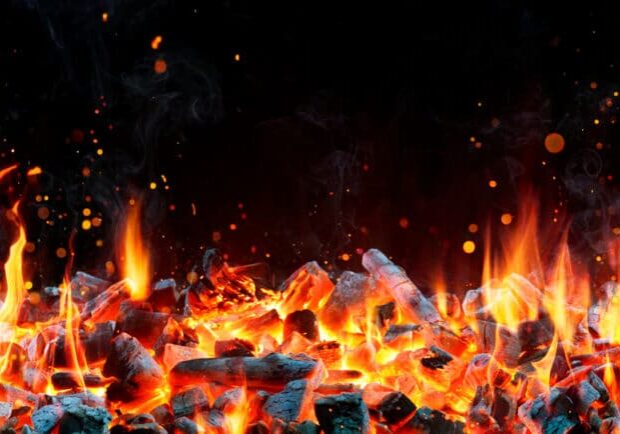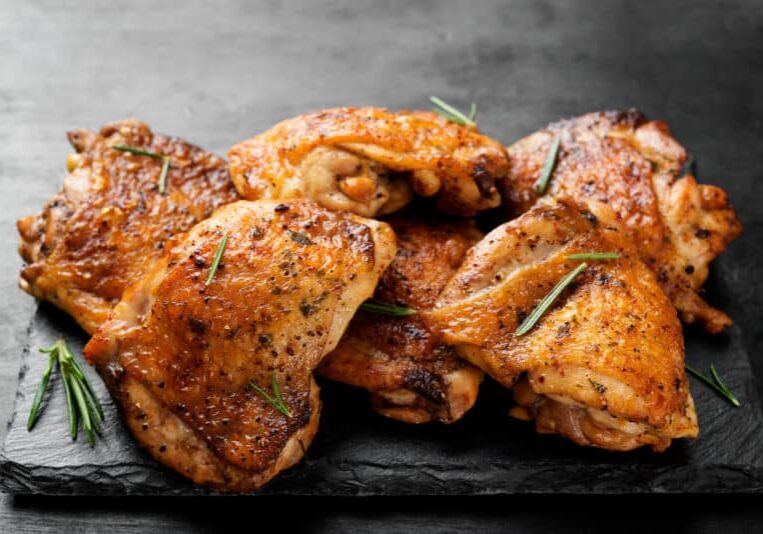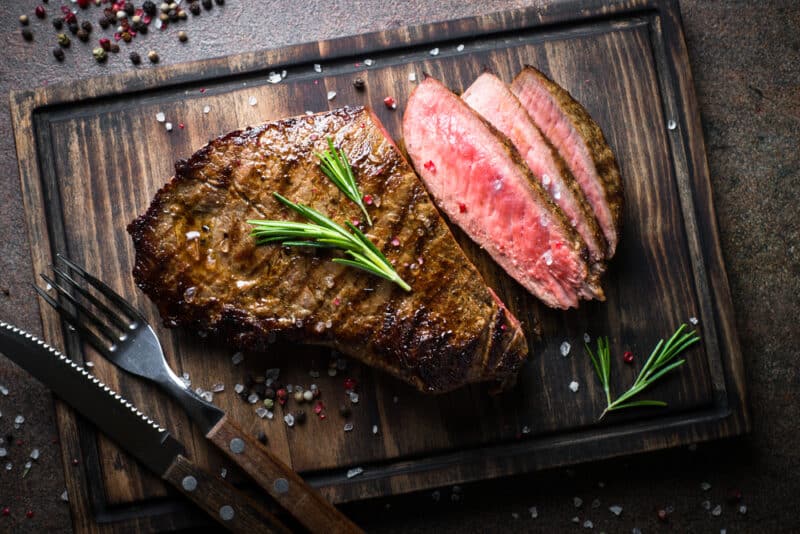Best Meat for Beef Jerky
TheGrillingMaster.com is reader-supported. If you buy something using the links on our site, we might earn an affiliate commission at no added cost to you. This helps us pay our staff to keep making awesome content for you!

Selecting the right cut of meat is essential when creating homemade beef jerky. The quality of the meat is what sets the jerky apart and this article will provide insight into which meats are most suitable.
The best meat for beef jerky is top round, bottom round, lifter or pectoral. Flank steak or skirt steak can also be used to create a mouth-watering beef jerky. These cuts provide the ideal combination of affordability, low-fat content, and rich flavor that make them ideal for beef jerky.
Beef jerky is a delicious and convenient snack that can be enjoyed on the go. Have you considered making your own beef jerky?
The process is not complicated. All you need to do is select the right type of meat.
In this article, we’ll explore the best cuts of meat for beef jerky and how to select the perfect piece for the perfect snack. If this is your first time making homemade jerky, this is where to start.
Even your first batch of jerky will be better than what you get at the grocery store.
Best Meat Cuts for Beef Jerky
Before you go shopping for beef to make your own jerky, you’d want to learn more about the different cuts and understand what makes one cut of meat more suitable than others. Let’s explore this to help you select the best.
1. What to Look for When Choosing Meat for Jerky
There’s an abundance of possibilities for you to pick from for beef jerky, and while there is no concrete rule for selecting the right cut of meat, we can provide you with some general advice to help you make the ideal decision.
Fat Content
When selecting beef for jerky, the primary factor to consider is its fat content. Leaner cuts are ideal since fat does not fully dehydrate and can cause the jerky to spoil more quickly. However, if you plan to eat the jerky quickly, a fattier cut will be fine.

Type of Fat
Select meat with the least amount of intermuscular fat, which is fat that encases the protein. This fat should be removed before beginning the jerky-making process.
Intramuscular fat, on the other hand, is the marbling between the muscle fibers and is beneficial to the jerky-making process as it contributes to tenderness, juiciness, and flavor.
A moderate amount of this type of fat is desirable, while too much should be avoided.
If your butcher grades meat as determined by the USDA, your options will be Prime, Choice, and Select.
Choosing Choice grade is the best option for jerky because it contains more marbling than Select grade, but not as much as Prime.
It typically contains an amount of fat that gives the jerky the desired texture without too much that could cause it to spoil quickly.
If you are concerned about the health effects of beef jerky – it depends on how you make it.
Consider the Cost
Making beef jerky can be costly, so you’d want to weigh the amount of fat they prefer with the cost of the meat per pound. Even relatively tough cuts of beef can be used to make tender jerky.
Once you have determined what types of cuts you like to buy, you could take advantage of weekly discounts and special offers.
Buy Enough
When dehydrating meat, you will end up with a reduced weight due to the loss of moisture. To ensure you have enough to make jerky, aim for a ratio of three pounds of meat for every one pound of the finished product.
Check Freshness
Purchase jerky meat that is not expired, and ideally as fresh as possible. Inspect the meat for any dark spots, strange odors, or connective tissue such as cartilage, tendons, and ligaments. Fresh meat is crucial.
TIP: It is always a good idea to be a friend of your local butcher.
Related reading >> Learn how to use a spritz to add more flavor
2. Best Beef Cuts for Flavorful Jerky
To make the tastiest beef jerky, the cuts used are of utmost importance. Here are the best cuts to use for producing jerky with rich flavor.
Eye of Round

- The eye of round cut from the round primal is a single oval muscle in the rear leg, and it is the most tender of the sub-primal cuts.
- It has some marbling and the grain runs lengthwise, which makes it easy to cut into strips.
- It’s quite affordable, making it a great budget-friendly choice for jerky.
- Before slicing, you’ll need to remove the fat cap, which can be done with a sharp knife.
Top Round

- Top round beef is the most used cut by commercial jerky makers.
- The top Round, also known as London Broil, is taken from the inside leg muscle located opposite the Bottom Round.
- It is not as soft as the Eye of Round or Sirloin Tip, but still softer than the Bottom Round which experiences more strain.
- Despite its texture, it still has a strong flavor.
Bottom Round
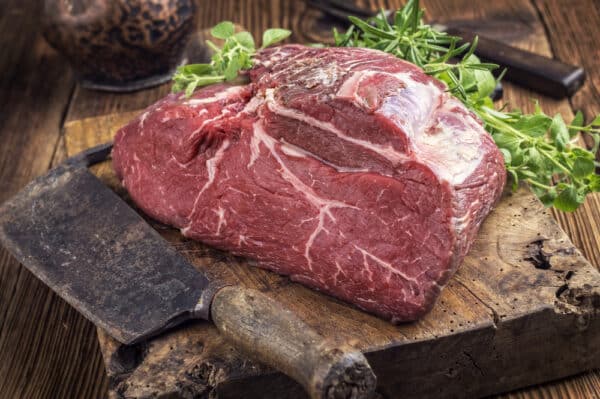
- The Bottom Round cut, also known as round roast, is taken from the outer muscle of the upper rear leg.
- It is not as tender as the other round steak cuts due to the hardworking nature of the part of the animal.
- However, it is still a great option when available.
Sirloin Tip

- The Sirloin Tip is not as well-known as other types of meat for jerky, yet it is one of the best.
- Finding it in regular stores may be challenging, but it is worth the effort.
- It’s relatively inexpensive and offers more flavor than other options while being a bit less tender than some.
- Do not mistake Sirloin Tip for the Top Sirloin, which comes from the Sirloin Primal.
3. Best Beef Cuts for Tender Jerky
The following beef cuts are most suitable if you prefer tender jerky.
Lifter Meat

- Lifter meat, also known as blade meat, cap, or wedge meat, is a great cut from the outside of the rib primal.
- It’s relatively thin and flat and has a medium amount of marbling.
- The jerky it creates will be both tender and full of flavor.
- For the best texture, slice the meat against the grain.
Pectoral Meat

- The Special Cut, or pectoral cut, is taken from the chuck primal.
- It has a small amount of marbling, similar to flank steak.
- Pectoral meat is an inexpensive option for jerky.
- It can be made into tender jerky, but it does lack flavor, so make sure you season it properly and marinate it in an extra flavorful marinade.
- Additionally, the meat is thin, making slicing a breeze.
Flank Steak

- Flank steak is cut from the flank primal and is a lean, flavorful meat with little fat or marbling.
- Its flavor is bold and meaty, but it is less tender than other cuts, so it is important to slice it against the grain.
- Furthermore, it is one of the more expensive cuts for beef jerky.
- It is also sometimes referred to as beef flank or plank steak.
4. Cuts Less Suitable for Jerky
Although some jerky makers prefer the following cuts, they are not the best choices, especially if you are new to making jerky. These are the worst cuts of meat for beef jerky:
Rib
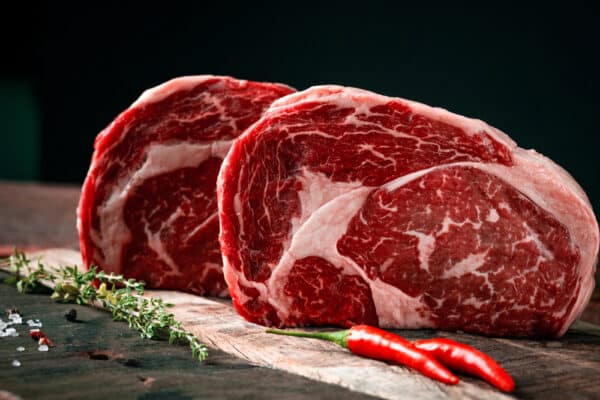
- Rib-eye is generally thought of as the best kind of steak, and making smoked ribs usually makes a delicious meal.
- When it comes to making beef jerky, rib meat is too delicate to cut into thin strips.
- It would disintegrate during the dehydration process.
Shank

- Shank meat is naturally quite tough and dry, making it difficult to chew.
- If one were to attempt to make jerky out of it, it would be so chewy and fibrous that it would be hard to eat.
Tenderloin

- The tenderloin is known for its marbled texture, making it the perfect source of succulent steaks like Filet Mignon and porterhouse.
- However, it is not ideal for jerky as the texture is too soft and there are more budget-friendly cuts that produce a better result.
- Jerky wants to be chewed, so melt-in-the-mouth tenderloin is preferred for feasting on.
- Therefore, tenderloin is not the best choice for jerky.
Brisket

- Brisket is too fatty to make jerky that will last without refrigeration, which limits its value as a convenient snack.
- We prefer the taste of BBQ or smoking a whole brisket, so we’d rather not spend time trimming it and cutting it into thin pieces.
5. Slicing Meat for Making Jerky
When making jerky, it is crucial to cut the meat against the grain, regardless of the type of meat you are using.
Doing it the wrong way will be especially noticeable. Cutting steaks against the grain will make them more tender, but when it comes to jerky, if you cut with the grain, it won’t be tender at all.
Frequently Asked Questions
Q: How do I make chewier jerky?
A: The way you slice the meat when you prepare the jerky determines how chewy the end result will be. For chewy jerky, you must cut the meat with the grain.
Q: Why is it best to choose a lean cut of meat for making jerky?
A: Lean meat is most suitable for beef jerky because fat doesn’t dry out and can cause the meat to be too moist, which reduces its shelf life since it will spoil faster. You don’t have to buy the leanest meat; some marbling is necessary for flavor.
However, if you prefer your jerky with a decent bit of fat, you should make small quantities that can be eaten sooner.
Q: Can I use wild game meat for making jerky?
A: Yes, you can use venison such as elk and deer are leaner than commercial beef and offer a distinct and enjoyable taste, making them one of the most desirable snacks.
Q: What is the best thickness to cut meat for jerky?
Slicing meat for jerky requires precision and attention to detail. If the slices are too thick, they will become chewy, and if they’re too thin, they’ll become tough. The perfect thickness for beef jerky slices is approximately one-quarter of an inch in thickness.
Final Thoughts
In conclusion, when it comes to making jerky, there is no one-size-fits-all answer to what the best beef cut is. One person’s best beef jerky may not be another one’s top choice. Depending on your preferences and the type of jerky you are making, you may prefer one cut over another.
The best cuts of beef for jerky are top round, bottom round, and eye of round, as well as flank steak, brisket, and sirloin tip. Regardless of the cut you choose, make sure to choose the best quality beef you can find for the most flavorful and enjoyable jerky.
Your next step will be to find the best beef jerky recipes.
Learn More About Grilling
If you want to learn more about grilling, check out these other helpful resources!

Kevin Turner
Hi there, I'm Kevin Turner, Founder and CEO of thegrillingmaster.com. I started this website to share my passion and knowledge with you. You can leverage my years of experience as a pit master and professional to grill great food!
About The Grilling Master
Hi there, I'm Kevin Turner, Founder and CEO of thegrillingmaster.com.
My passion has always been grilling, smoking and BBQ delicious meats that satisfy my inner carnivore!
I started this website to share my passion and knowledge with you, the hungry reader who wants to prepare the perfect meal.
You can leverage my years of experience as a pit master and professional.
Send me a message and let's connect on Twitter here.





